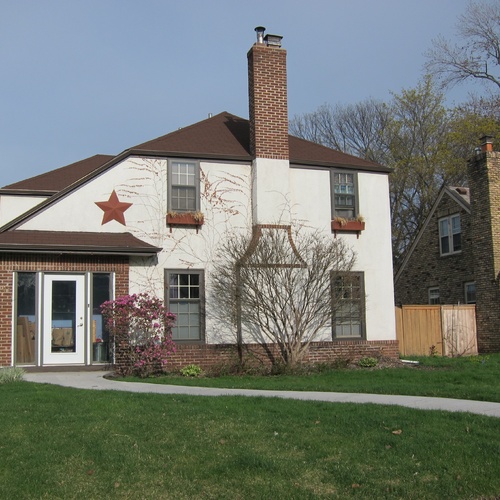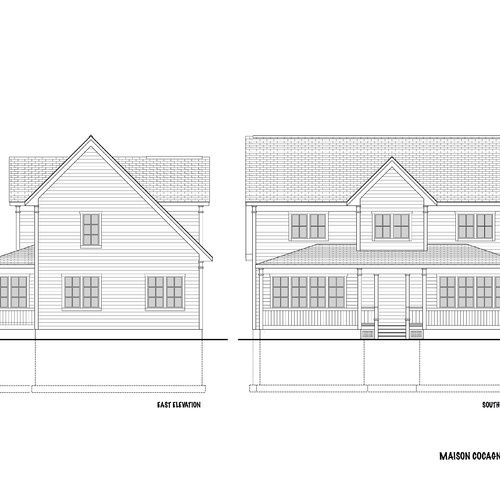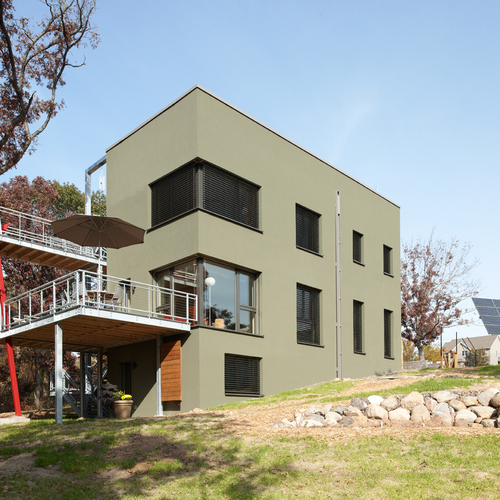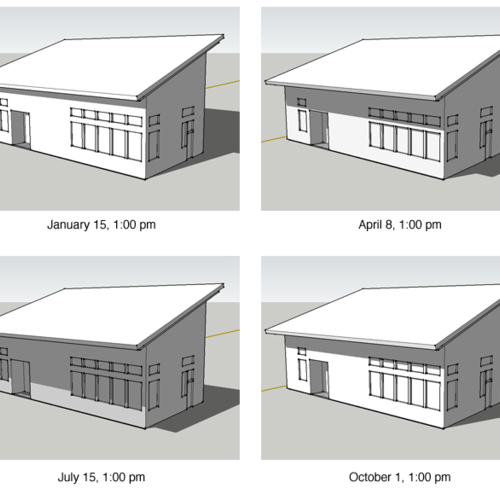Vent panels in Passivhaus construction
Brute Force Collaborative's interest in Passivhaus design prompted a look at using vent panels instead of operable windows, as in this Tham & Videgard Hansson projectImage Credit: Brute Force Collaborative
Vent panels in Passivhaus construction
Brute Force Collaborative's interest in Passivhaus design prompted a look at using vent panels instead of operable windows, as in this Tham & Videgard Hansson projectImage Credit: Brute Force Collaborative Meet Brute and Force. Aaron Yankauskas (left) and Michael Eliason earned their nicknames on a university project building a rammed earth house.
One of the most appealing things about the web are the unplanned side trips you take on the way to somewhere else, which is how I found myself at Brute Force Collaborative, a blog with a special focus on Passivhaus projects.
BFC is the work of two Passivhaus designers, Michael Eliason and Aaron Yankauskas, who went to school together at Virginia Tech’s College of Architecture and Urban Studies, and then worked for a time in Germany. Both eventually settled in Seattle.
“We’re initiating this blog to provide an outlet for opening up green dialog beyond LEED and associated greenwashing,” they write. “It is our goal to advance the green discussion beyond ‘sustainable’ carpets and bike racks – and moving it towards sensible, intelligent green design. This will manifest itself through the documentation of green architects, projects and building techniques that hopefully some of you may find useful.”
Both designers have a “major soft spot for small, green and well-detailed projects,” and, it seems, for Passivhaus, the ultra-low energy building standard that originated in Germany and is now making headway in the U.S. In addition to projects around the Pacific Northwest you also can read about ongoing work on the other side of the Atlantic, and that gives BFC unusual breadth.
One section of their blog is Passivhaus-only. Here you’ll find a good description of what the building standard is all about, and also a number of links to Passivhaus projects that are currently underway. Included are links to explanations of common terms, such as “thermal bridging” or “heat-recovery ventilator,” that will be useful to those just starting their forays into green building. (Full disclosure: GreenBuildingAdvisor is among the sources they cite.)
There are other sections as well, such as “elevating the discourse,” “greener architects,” and “sustainable practices.” In all, you’ll find plenty to read and some excellent leads to a variety of other blogs, designers and web sites.
And the unusual name for the blog?
“We were in a studio that designed and built a rammed earth house,” Eliason explained in an e-mail. “We were the guys who were always on site — rain or shine — digging trenches, moving dirt, trying to keep things moving along. Often quickly, albeit without much grace. Eventually, our professors dubbed us ‘brute’ and ‘force.’ We prefer to work collaboratively on a lot of things and are able to bounce ideas off each other rather well, and so ‘brute force collaborative’ just seemed to fit.”
On rethinking our fixation on multiple bathrooms
“The upper floor features 3 bedrooms and one bathroom shared by the entire household. I know my parents and half of the United States just collectively freaked out – but this is fairly common in Europe. It is one of the best ways to keep energy and water use (as well as construction costs) down. Yes, it does take better planning in the morning, but really, wouldn’t you rather have one incredible bathroom instead of 3 mediocre ones?”
On the importance of high performance windows
“We can’t reinforce this enough, Passivhaus windows should be energy positive, which can potentially reduce the amount of thermal insulation (and therefore carbon footprint) needed.”
On the benefits of Passivhaus
“We’ve been following PH for a few years, and are rather excited to see this post-LEED standard reach critical mass. Passivhaus is not only a proven route towards net zero, but a green building standard that routinely outperforms LEED where it counts: energy efficiency. And while having bike racks, ZEV parking, low/zero-VOC paints and recycled construction waste are good things – to us, that is really the starting point.”
On getting away from petroleum-based products
“We’re not big fans of the ‘thermos’ analogy for Passivhaus (probably stemming from my insulation-free days in Freiburg), and are highly motivated and interested in developing strategies to build Passivhaus buildings without layers of petroleum-based insulation above, below and outside of the home.”
On discovering new building materials
“As a young architecture praktikant in Germany, I quickly realized everything I knew about wooden construction was outdated, inefficient and irrelevant. My first experience with modern European timber practices was a polycarbonate-wrapped house that utilized brettstapel (mfr: Bresta).
“Brettstapel is, effectively, 2x boards mounted on dowels that are fabricated off-site and erected as panels. Quick, easy, effing brilliant. Brettstapel can be utilized for walls, floors and roofs. The products are available in various dimensions for acoustic and visual preferences.
“From here, my spidey-intern senses went nuts, and I realized that there was something very desirable, very sexy about these panels. It comes pre-finished, installs quickly, incorporates low-grade rapid-growth lumber effectively, sequesters carbon and can be optimized for thermal storage (a topic for the next post). Amazingly, building with CLT is like building study models with chipboard – you place a window wherever you want.”
On discovering that buying European windows saves C02
“This was shocking to us, as we expected the numbers to be significantly closer. Of course, the locally manufactured windows had the lowest transportation CO2 production – that only makes sense. However, the superior frames and glazing from Europe require significantly less insulation in the envelope.
“This definitely seems backwards and goes against conventional wisdom, but in this instance, shipping windows from Europe saves CO2 – a whole lot of CO2. In fact, with an average of 14,634 lbs CO2 for the three North American options, the European windows can save six tons of CO2 emissions. That is not insignificant, and something to keep in mind if North American manufacturers don’t think that developing high performance glazing is a worthwhile venture.”
Mike Eliason has written a guest blog for GBA: A Passivhaus Rebuttal.
Weekly Newsletter
Get building science and energy efficiency advice, plus special offers, in your inbox.
















20 Comments
These guys rock.
Keep an eye on this one. Checking in to BFC occasionally will shock you out of the stylistic and functional "blahs".
If you haven't read the blog entry that makes the examination of high R, SHGC European windows vs North American and the related carbon foot print based on import... Read it. It's truly shocking and counter intuitive. What I like about these guys is that they actually saw it as a "question".
Brettstapel
Would love to see more of this kind of material the focus of US green building discussions. Yay for enhanced carbon sequestration in our building materials. Yay for thermal mass that is naturally warm to the touch. Yay for component-level prefabrication which still requires local skills for assembly. Yay for better uses of renewable fast-growing low-grade lumber that doesn't involve huge quantities of glue. Yay for energy-efficient construction that minimizes the use of concrete and plastic foam insulation.
Note that in the attached video the narrator's uses the phrase 'timber frame' in the British sense - he's talking about what we'd call stick frame.
http://www.youtube.com/watch?v=-5BZz5CZBHw&feature=player_embedded#at=241
Response to James Morgan
James,
I just watched the YouTube video. I find it a strange argument -- that the best way to sequester carbon is to build new buildings with lots of lumber and wood products in them. Make the walls thick! Include as much wood as you can! And cut down lots of trees to sequester more carbon indoors!
Well, yes, that works ... as long as you keep a solid roof overhead, and a good foundation underneath, so the wood never rots and returns its carbon to the atmosphere.
But really, James: building lots of new wooden buildings is a crazy method of carbon sequestration. We'd have to be nuts to endorse this.
As an extreme example of the philosophy behind this approach, I have advocated (tongue-in-cheek) that the government hire loggers to cut as much firewood as possible, and build thousands of big barns to store the firewood in. Don't ever burn the firewood! Just cut it down and store it. We need more barns every year, remember. Now THAT'S a carbon sequestration program that will put people back to work.
Sequestration
Tongue in cheek or not, sequestration (by trees) only works if you maintain or increase your forest cover. Here in the Northwest we have a lot of forest, but a lot less than we used to, especially in the lowlands.
isolation
the CO2 argument only works in isolation
say had you not cut down the tree to make the window frame, that tree would have kept growing consuming more CO2. you have to factor in some weird potential life assumptions, and it starts to get complicated
what about no window frames??
just by sheets of glass and gasket them to your assembly
works just fine in automobiles
cross laminated timber and CO2 sequestration
austrian CLT is harvested from managed, fast growing forests (and i believe the developments underway in BC call for the same thing). this lumber is ideal for carbon sequestering - it sits around in a house for 100+ years and in that time, the carbon stored in regrowth that is subsequently harvested where the original tree was felled more than makes up for the eventual decay of the original tree.
bob,
we've been looking at the utilization of achieving passivhaus by glass alone or site built windows instead of any manufactured windows at all, and the performance seems to be exponentially better. of course, this does introduce other issues to contend with, but could conceivably allow north american glass (cardinal 179/180, etc) to perform as well as some of the insane glass being developed in europe. granted, importing european glass and doing the same thing could mean getting away with significantly more window area or higher percentage of glazing...
Carbon sequestration vs. Permaculture
This timber / carbon argument sounds like a trap with inevitable unforeseen consequences. In a permaculture model you need every living thing to operate within a closed loop. Can a forest continuously export massive quantities of biomass without depleting the soil?
CO2
Mike,
Great blog, and I'm really looking forward to your guest post here.
I don't quite buy that wood is carbon negative, but it is definitely less carbon intensive than other building materials. Straw and bamboo may be even better than wood, though. I think the point of the video is that a building with concrete and steel and PV uses more CO2 than a building built with this particular wood system and no PV.
Also, an interesting fact about windows: A window shipped from Germany to New York will have a lower carbon transportation footprint than one trucked from Wisconsin. And a better factoid for cocktail parties: A bottle of French wine, poured in New York, has a lower carbon footprint than a bottle of California wine.
Reply to Martin:
"I find it a strange argument -- that the best way to sequester carbon is to build new buildings with lots of lumber and wood products in them. Make the walls thick! Include as much wood as you can! And cut down lots of trees to sequester more carbon indoors!"
Straw man - who says it's the 'best way to sequester carbon'? The suggestion is that when we make choices of building materials, their potential for beneficial carbon sequestration can and should be taken into account.
"Well, yes, that works ... as long as you keep a solid roof overhead, and a good foundation underneath, so the wood never rots and returns its carbon to the atmosphere."
Exactly. Your point?
"But really, James: building lots of new wooden buildings is a crazy method of carbon sequestration. We'd have to be nuts to endorse this."
We are already building lots of new buildings. Why is it nuts to look to achieve carbon sequestration as one of the benefits by which we justify the financial and environmental costs of these buildings?
"As an extreme example of the philosophy behind this approach, I have advocated (tongue-in-cheek) that the government hire loggers to cut as much firewood as possible, and build thousands of big barns to store the firewood in. Don't ever burn the firewood! Just cut it down and store it. We need more barns every year, remember. Now THAT'S a carbon sequestration program that will put people back to work."
Well that'd work, if you could just persuade the gov'mint to pay for it and keep folks from breaking into the barns to burn all that wood. But why not just sequester the wood safely and usefully in a house?
Seriously, why should we not prefer to use optimized carbon-sequestering wood products to carbon-emitting steel, concrete brick, plastic and gypsum?
Reply to Thomas Jefferson
Good question on biomass depletion. I've asked the same question in discussions with advocates of cellulosic ethanol. What I think makes the difference is that burning wood, either directly or as liquid fuel is only long-term carbon-neutral and short-term carbon-positive, while using it for building is both short and long-term carbon-negative, to the extent we can keep our buildings intact and in use for the long term, so it may well be worth the biomass loss in our critical carbon balance condition.
And we should always be on the lookout for unintended consequences. But I do not think there is likely to be a conflict between managed forestry and permaculture: the first is *extensive*, generally practiced on land which is remote from human settlement; the other is *intensive* and intended to support a close human community. Trees are every kind of miraculous - they mostly do not need a lot of soil to grow, pulling carbon from the air and raw sunlight and water from the sky to produce the cellulose which supports their grand structures and which we find so useful in so many ways.
Carbon Sequestration
Lime plaster skins sequester carbon for many years in order to cure and turn back into "stone".
More on sequestration
James,
I don't want to beat a dead horse. I agree that wooden buildings are less carbon-intensive than concrete buildings.
Let's imagine a world at a steady state. (OK, I recognize that this vision assumes a stable population. But bear with me.) In such a world, let's say that one million wooden homes rot every year, releasing their carbon to the atmosphere. Builders replace these old rotting homes by building one million new homes a year -- using lots of wood, naturally, to "sequester carbon."
But in fact, the carbon is balanced -- one million homes release their carbon into the atmosphere, while one million homes' worth of trees are cut down to do new construction.
Besides the obvious question of whether worldwide logging practices are sustainable, your claim that carbon can be sequestered by building new homes only works in a world with more and more homes every year. The new homes have to outnumber the rotting homes. That's not sustainable -- and that's not a world in which I want my grandchildren to live. It's a vision of marching suburbs, gobbling up undeveloped land.
Correct Terms
I agree with Martin and think we should refer to using sustainably harvested wood as CARBON NEUTRAL, and not carbon sequestering. Go back after trees are cut and you'll realize it's apples and turds.......
gobbling suburbs!
Martin,
It doesn’t have to be that way… Cities contain lots of poorly developed land than can be better utilized, and the great thing about cross laminated timber is that it is ideal for low-mid rise buildings like the Waugh Thistleton building in London, or this beautiful kaden|klingebeil architekten infill project in Berlin: http://architecturelab.net/10/e_3-housing-in-berlin-by-kaden-klingbeil-architekten/
What it will take is progressive building departments, however…
Unsteady assumptions
Martin, implicit in your steady state theory is the assumption not only that population is stable but that all homes are the same size and all homes contain exactly the same amount of wood. None of these assumptions are anywhere near correct. Homes and populations get steadily bigger, so the construction which you decry is already happening - duh - most if not all of the readers and contributors at GBA are in the business of building, designing remodeling and commissioning these buildings. Meanwhile the amount of wood used in new homes as a proportion of total material use has been steadily dropping as the use of concrete, steel and plastics has increased. This is not a good trend. These latter are materials which release substantial carbon into the atmosphere in the course their manufacture, fabrication and installation. The atmospheric carbon balance contribution of lumber from managed woodlands may be subject to some discussion and variation from country to country and climate to climate but there is no debate that in many if not most situations it is far better than any of these.
The inference is that other considerations being equal (another assumption of course) a preference for more rather than less wood-intensive construction practices is likely to be beneficial in carbon balance terms. This may be counterintuitive and fly in the face of traditional 'save a tree, man' environmentalism but it is not crazy.
Biomass and Soil
A quote from David Montgomery's book, "Dirt, The Erosion of Civilizations" shows how this question was asked long ago:
"In the early 1600s Belgian philosopher Jan Baptista van Helmont tried to settle the question of whether plants were made of earth, air, fire, or water. He planted a seedling tree in two hundred pounds of soil, protected it from dust, and let it grow for five years, adding only water. Finding that the tree had grown by one hundred and seventy pounds, whereas the soil had lost an insignificant two ounces, van Helmont concluded that the tree had grown from water---the only thing added to the process. . . . it took a few more centuries before people discovered carbon dioxide and came to understand photosynthesis."
This book is a bit scholarly, but still a very interesting read. I highly recommend it to GBA folk.
It's not the removal of the tree that degrades the soil, it is the process of HOW it's harvested. Remember that much of a tree's biomass remains hidden below the ground in the form of its root system (iceburg analogy), and this biomass remains after harvesting, feeding soil organisms and adding humus. Where the tree is growing (percent slope), site access, how the tree is harvested, and what happens to the soil afterwards are MUCH more important issues related to soil loss.
Silviculture isn't necessarily evil, it's just that there are plenty of examples of past (and present) abuse and poor management.
Regarding our current ethanol production process (i.e. corn), the evidence is clear that we are trading ethanol for massive soil erosion / loss / degradation.
Daniel
Nice post about
Daniel
Nice post about biomass and soil. The whole process of photosynthsis is about the closest thing we can get to "a free lunch" in the natural world.
Your last sentence however, could use some further explanation. Perhaps you can cite some peer reviewed studies to show that "the evidence is clear". Don't get me wrong...I am not a fan of ethanol, but modern farming has become quite good at soil conservation.
Soil Conservation
Garth,
A few months ago I read Wendell Berry's book, "The Gift of Good Land: Further Essays Cultural and Agricultural." Although somewhat dated (1980), he made a statement in several different essays that I found astonishing. To paraphrase, he said that in the Iowa corn belt, we are losing six bushels of soil for every bushel of harvested corn.
Note that his essays were written forty-some years after the "Soil Conservation Act" was enacted by Congress . . . and almost two hundred years after Thomas Jefferson warned of abusive agricultural practices in America.
I would agree that modern farming is improving, but I disagree with the perspective that it is "quite good at soil conservation."
You can find loads of information on the subject here, at the National Resources Inventory:
http://www.nrcs.usda.gov/technical/NRI/2007/2007_NRI_Summary.pdf
And in the following chart, you can see that the most recent survey shows that, in Corn Belt cropland, we are still losing 4.1 tons of topsoil per acre per year:
http://www.nrcs.usda.gov/technical/NRI/2007/images/m10979_lg.png
If you were to use that "official" soil loss number against an average Iowa corn yield ~ 170 bushels per acre, then it still comes out to 48 lb. of soil loss per bushel of corn. If the ethanol refineries can produce 2.7 gallons of ethanol per bushel of corn, then it works out to ~ 18 lb. of soil loss per gallon of ethanol. Note that these are my calculations, with data pulled from other reliable sources.
Beyond the subject of erosion, the fact is that you can't improve or build soil with continuous monoculture cropping and chemical fertilizer inputs. It requires fallow fields, adding plant biomass, or adding biomass that has been processed through a ruminant ;-)
I'm certainly not an expert on the issue---I'm trying to educate myself---but I hope this provides some perspective on my comment.
More on soils
Apologies to the OP for the hijack and change of subject to soils...
Daniel, glad to see your interest in soils. I began my farming life at about 1980...the same time described in Berry's book. I do not dispute his claims about soil erosion from that time. I witnessed it and it was awful. About that time it was beginning to be recognized that tillage was causing most of the damage. And since about 1985 or so, zero tillage farming methods started to be refined and enhanced. Today, where I farm, about 80% of grain farmers use these methods and more are added each year. The change to the soils themselves are dramatic and very encouraging. Here is a link to some discussion regarding these changes.
http://www.ssca.ca/conference/2001proceedings/halford.html
No Till
Thanks for the link Garth. Here's one more link I think you will find interesting:
http://www.cedarmeadowfarm.com/default.html
Steve Groff takes no till a couple of steps further. First, he allows the cover crop (mainly rye) to reach the milky kernel stage, producing a much greater quantity of biomass than industrial no till methods. Second, he uses a roller-crimper to lay down and kill the rye before planting the primary crop (instead of an herbicide).
I don't see this as a thread hijack. Without soil, there wouldn't be any life---no trees, no humans, no buildings. Soil conservation is just as important for silviculture and "green" building as it is for crop farming. And healthy soil sequesters a considerable amount of carbon too . . .
Log in or create an account to post a comment.
Sign up Log in